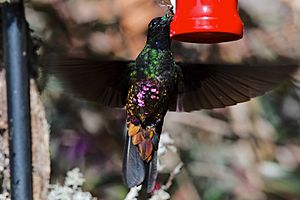Blue-throated starfrontlet facts for kids
Quick facts for kids Blue-throated starfrontlet |
|
|---|---|
 |
|
| Conservation status | |
| Scientific classification | |
| Genus: |
Coeligena
|
| Species: |
helianthea
|
 |
|
| Synonyms | |
|
Helianthea typica |
|
The blue-throated starfrontlet (Coeligena helianthea) is a beautiful type of hummingbird. These tiny, fast birds are known for their bright colors and quick movements. The blue-throated starfrontlet belongs to a group of hummingbirds called "brilliants." You can find this special bird living in the countries of Colombia and Venezuela.
Contents
About the Blue-throated Starfrontlet
Hummingbirds like the blue-throated starfrontlet are sorted into groups by scientists. This helps us understand how they are related. For a long time, this bird was in a different group called Helianthea. But since the mid-1900s, scientists decided it fits better in the Coeligena group. There are two slightly different kinds, or subspecies, of the blue-throated starfrontlet:
- C. h. helianthea (the main type)
- C. h. tamai
What Does the Blue-throated Starfrontlet Look Like?
The blue-throated starfrontlet is about 13 centimeters (5 inches) long. That's roughly the length of a pen! Male birds weigh a bit more than females. Both male and female birds have a long, straight, black beak, perfect for sipping nectar. They also have a white spot behind each eye. Their tails are a shiny bronzy black and are forked, like a swallow's tail, but the male's tail is more deeply forked.
If you see this bird in dim light, it might look completely dark. But in good light, you can see its amazing colors!
- Male Birds: They have a black head with a dark green forehead. Their upper body is a dark, shiny emerald green. Their lower back and rump (the area above the tail) are dark blue with some violet. The most striking part is their throat, which is a bright, shimmering violet. Their chest is dark gray with a green shine, and their belly and under-tail feathers are rosy pink.
- Female Birds: They have a gray-green head and golden-green upper parts that fade into a blue-violet rump. These colors are not as bright as the male's. Their throat and chest are a reddish-brown, with green spots on the chest. Their belly is rosy, and their under-tail feathers are a lighter rose color.
The C. h. tamai subspecies is very similar, but the males are a bit duller. Their belly and under-tail feathers are more bluish than rosy. The females of both subspecies look almost the same.
Where Do These Hummingbirds Live?
The blue-throated starfrontlet lives in the Andes mountains. The main subspecies, C. h. helianthea, is found in northern and eastern Colombia. This includes an area called the Serranía del Perijá, which is on the border between Colombia and Venezuela. It also lives south and west towards the big city of Bogotá.
The C. h. tamai subspecies lives in a specific mountain area called the Tamá Massif in western Venezuela.
These hummingbirds love to live inside and at the edges of cloudforests and elfin forests. These are special types of forests found in high mountains, often covered in mist. They also live on shrubby slopes and sometimes in bushy areas at the bottom of open grasslands called páramo. You might even spot them in flowering gardens! They usually live at elevations between 1,900 and 3,300 meters (about 6,200 to 10,800 feet) above sea level.
How Do Blue-throated Starfrontlets Behave?
Moving Around
Scientists don't know much about how far blue-throated starfrontlets travel. However, they probably move up and down the mountains depending on the season. This is called making "seasonal elevational changes."
What Do They Eat?
The blue-throated starfrontlet mainly eats nectar from flowers. They are very clever about it! They use a method called "trap-lining." This means they visit a regular path of many different flowering plants, almost like they have a secret route. They usually look for food close to the ground. Besides nectar, they also catch small insects and spiders. They do this by picking them off leaves or sometimes by catching them in the air, which is called "hawking."
When Do They Have Babies?
The breeding season for the blue-throated starfrontlet is from May to October. Not much else is known about how they raise their young.
What Do They Sound Like?
The sounds these hummingbirds make are not very well known. But they do make a single, sharp "chit" sound.
Is the Blue-throated Starfrontlet Safe?
The IUCN (International Union for Conservation of Nature) has looked at the blue-throated starfrontlet and says it is a species of "Least Concern." This means they are not currently in danger of disappearing. However, we don't know exactly how many of them there are or if their numbers are growing or shrinking.
Even though they are common in some areas and can live in gardens created by people, their natural homes are being lost because of deforestation (when forests are cut down). It's important to protect their habitats so these beautiful birds can continue to thrive!
See also
 In Spanish: Inca ventrivioleta para niños
In Spanish: Inca ventrivioleta para niños



